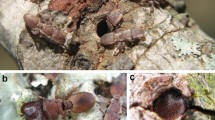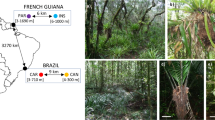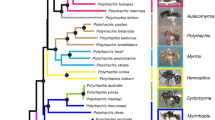Abstract
This work uses a comparative framework to address the adaptive evolutionary relationship between nesting ecology and the morphological diversification of the soldier caste in turtle ants (Cephalotes). Turtle ant colonies nest in pre-existing arboreal cavities, and soldiers specialize in colony defense by blocking cavity entrances with their armored heads. Analyses were focused on three major axes of soldier morphological diversification: discrete morphotype, head size, and head-size range (i.e., soldier polymorphism). The analyses showed that while all species use some entrances small enough to fit the head of one soldier, specialization on entrances that tightly fit the head of one soldier was only seen in species with the most specialized soldier morphotype. They also showed that the degree of soldier polymorphism was only positively correlated with the typical range of entrances in species with the most specialized morphotype. Overall, these findings indicated that a tight 1:1 size-matching between available soldier head sizes and selected entrance sizes is limited to species with the most specialized soldier morphotype, while species with less specialized morphotypes use a broader range of larger entrances. Together, these findings suggest a new general hypothesis for the adaptive diversification of caste systems: major shifts in ecological specialization drive the evolution of novel caste morphotypes, while minor expansions and contractions of an existing resource range shape the evolution of the size distribution of an existing caste. Broadly, these findings highlight the possibility for complex coupling and decoupling between different axes of caste diversification in lineages with complex social phenotypes.
Significance statement
One key way in which complex "organismal societies" have diversified in form and function is via the evolution of morphologically distinct "castes" that specialize on particular social roles. Nevertheless, how ecological interactions shape caste diversification within social lineages remains poorly understood. Using a comparative framework, this work addresses how nesting ecology has shaped the diversification of an elaborate soldier caste in the turtle ants. The evolution of more specialized soldier types was associated with substantial shifts in nest-entrance specialization, while in species with the most specialized soldier type, there was also a match between head sizes and entrance sizes within and across species. These findings suggest the general hypothesis that the evolution of novel caste types is driven by major shifts in ecological specialization, while the size distribution of existing castes tracks minor shifts in resource use.





Similar content being viewed by others
References
Arnold SJ (2003) Performance surfaces and adaptive landscapes. Integr Comp Biol 43:367–375. doi:10.1093/icb/43.3.367
Baroni Urbani C (1998) The number of castes in ants, where major is smaller than minor and queens wear the shield of the soldiers. Insect Soc 45:315–333. doi:10.1007/s000400050091
Billick I (2002) The relationship between the distribution of worker sizes and new worker production in the ant Formica neorufibarbis. Oecologia 132:244–249. doi:10.1007/s00442-002-0976-7
Blomberg SP, Garland T Jr, Ives AR, Crespi B (2003) Testing for phylogenetic signal in comparative data: behavioral traits are more labile. Evolution 57:717–745. doi:10.1554/0014-3820(2003)057[0717:tfpsic]2.0.co;2
Bourke AFG (2011) Principles of social evolution. Oxford University Press, Oxford
Burd M (2000) Body size effects on locomotion and load carriage in the highly polymorphic leaf-cutting ants Atta colombica and Atta cephalotes. Behav Ecol 11:125–131. doi:10.1093/beheco/11.2.125
Camarota F, Powell S, Vasconcelos HL et al (2015) Extrafloral nectaries have a limited effect on the structure of arboreal ant communities in a Neotropical savanna. Ecology 96:231–240. doi:10.1890/14-0264.1
Creighton WS (1963) Further studies on the habits of Cryptocerus texanus Santschi (Hymenoptera: Formicidae). Psyche 70:133–143. doi:10.1155/1963/78162
Creighton WS, Gregg RE (1954) Studies on the habits and distribution of Cryptocerus texanus Santschi (Hymenoptera: Formicidae). Psyche 61:41–57. doi:10.1155/1954/37696
Creighton WS, Nutting WL (1965) The habits and distribution of Cryptocerus rohweri Wheeler (Hymenoptera: Formicidae). Psyche 72:59–64. doi:10.1155/1965/79407
Cruz YP (1981) A sterile defender morph in a polyembryonic hymenopterous parasite. Nature 294:446–447. doi:10.1038/294446a0
Darwin C (1859) On the origin of species. (Facsimile of 1st edition, 1964). Harvard University Press, Cambridge
de Andrade ML, Baroni Urbani C (1999) Diversity and adaptation in the ant genus Cephalotes, past and present. Stuttgarter Beitr Naturk Ser B 271:1–889
Dornhaus A, Powell S (2010) Foraging and defence strategies. In: Lach L, Parr CL, Abott KL (eds) Ant ecology. Oxford University Press, Oxford, pp 210–230
Duffy JE (1996) Eusociality in a coral-reef shrimp. Nature 381:512–514. doi:10.1038/381512a0
Felsenstein J (1985) Phylogenies and the comparative method. Am Nat 125:1–15. doi:10.1086/284325
Grafen A (1989) The phylogenetic regression. Phil Trans R Soc B 326:119–157. doi:10.1098/rstb.1989.0106
Grüter C, Menezes C, Imperatriz-Fonseca VL, Ratnieks FLW (2012) A morphologically specialized soldier caste improves colony defense in a neotropical eusocial bee. PNAS 109:1182–1186. doi:10.1073/pnas.1113398109
Hasegawa E (1993) Nest defense and early production of the major workers in the dimorphic ant Colobopsis nipponicus (Wheeler) (Hymenoptera : Formicidae). Behav Ecol Sociobiol 33:73–77. doi:10.1007/BF00171658
Hechinger RF, Wood AC, Kuris AM (2011) Social organization in a flatworm: trematode parasites form soldier and reproductive castes. Proc R Soc B 278:656–665. doi:10.1098/rspb.2010.1753
Irschick D, Dyer L, Sherry TW (2005) Phylogenetic methodologies for studying specialization. Oikos 110:404–408. doi:10.2307/3548481?ref=no-x-route:4b549cd8ee0052f607e462ad017fdd31
Irschick DJ, Meyers JJ, Husak JF, Le Galliard J-F (2008) How does selection operate on whole-organism functional performance capacities? A review and synthesis. Evol Ecol Res 10:177–196
Kaspari M (1996) Worker size and seed size selection by harvester ants in a neotropical forest. Oecologia 105:397–404. doi:10.1007/BF00328743
Kempf WW (1951) A taxonomic study on the ant tribe Cephalotini (Hymenoptera: Formicidae). Revta Bras Ent 21:1–244
Losos JB (2010) Adaptive radiation, ecological opportunity, and evolutionary determinism. Am Nat 175:623–639. doi:10.1086/652433
Losos JB (2011) Seeing the forest for the trees: the limitations of phylogenies in comparative biology. Am Nat 177:709–727. doi:10.1086/660020
Mcginley RH, Prenter J, Taylor W (2013) Whole-organism performance in a jumping spider, Servaea incana (Araneae: Salticidae): links with morphology and between performance traits. Biol J Linnean Soc 110:644–657. doi:10.1111/bij.12155
McLeish MJ, Chapman TW (2007) The origin of soldiers in the gall-inducing thrips of Australia (Thysanoptera : Phlaeothripidae). Aust J Entomol 46:300–304
Mertl A, Traniello J (2009) Behavioral evolution in the major worker subcaste of twig-nesting Pheidole (Hymenoptera: Formicidae): does morphological specialization influence task plasticity? Behav Ecol Sociobiol 63:1411–1426. doi:10.1007/s00265-009-0797-3
Moreau CS (2008) Unraveling the evolutionary history of the hyperdiverse ant genus Pheidole (Hymenoptera: Formicidae). Mol Phylogenet Evol 48:224–239. doi:10.1016/j.ympev.2008.02.020
Mowles SL, Cotton PA, Briffa M (2010) Whole-organism performance capacity predicts resource-holding potential in the hermit crab Pagurus bernhardus. Anim Behav 80:277–282. doi:10.1016/j.anbehav.2010.05.004
O'Riain MJ, Jarvis JUM, Alexander R et al (2000) Morphological castes in a vertebrate. PNAS 97:13194–13197
Orme D, Freckleton R, Thomas G, Petzoldt T, Fritz SA, Isaac N, Pearse W (2015) caper: Comparative Analyses of Phylogenetics and Evolution in R version 0.5.2
Oster GF, Wilson EO (1978) Caste and ecology in the social insects. Princeton University Press, Princeton
Pagel M (1999) Inferring the historical patterns of biological evolution. Nature 401:877–884. doi:10.1038/44766
Pepper JW, Herron MD (2008) Does biology need an organism concept? Biol Rev 83:621–627. doi:10.1111/j.1469-185X.2008.00057.x
Pie MR, Traniello JFA (2007) Morphological evolution in a hyperdiverse clade: the ant genus Pheidole. J Zool 271:99–109. doi:10.1111/j.1469-7998.2006.00239.x
Porter SD, Tschinkel WR (1985) Fire ant polymorphism (Hymenoptera: Formicidae): factors affecting worker size. Ann Entomol Soc Am 78:381–386. doi:10.1093/aesa/78.3.381
Powell S (2008) Ecological specialization and the evolution of a specialized caste in Cephalotes ants. Func Ecol 22:902–911. doi:10.1111/j.1365-2435.2008.01436.x
Powell S (2009) How ecology shapes caste evolution: linking resource use, morphology, performance and fitness in a superorganism. J Evol Biol 22:1004–1013. doi:10.1111/j.1420-9101.2009.01710.x
Powell S, Dornhaus A (2013) Soldier-based defences dynamically track resource availability and quality in ants. Anim Behav 85:157–164. doi:10.1016/j.anbehav.2012.10.020
Powell S, Franks NR (2005) Caste evolution and ecology: a special worker for novel prey. Proc R Soc B 272:2173–2180. doi:10.1098/rspb.2005.3196
Powell S, Franks NR (2006) Ecology and the evolution of worker morphological diversity: a comparative analysis with Eciton army ants. Func Ecol 20:1105–1114. doi:10.1111/j.1365-2435.2006.01184.x
Powell S, Franks NR (2007) How a few help all: living pothole plugs speed prey delivery in the army ant Eciton burchellii. Anim Behav 73:1067–1076. doi:10.1016/j.anbehav.2006.11.005
Powell S, Costa AN, Lopes CT, Vasconcelos HL (2011) Canopy connectivity and the availability of diverse nesting resources affect species coexistence in arboreal ants. J Anim Ecol 80:352–360. doi:10.1111/j.1365-2656.2010.01779.x
Powell S, Del-Claro K, Feitosa RM, Brandão CRF (2014) Mimicry and eavesdropping enable a new form of social parasitism in ants. Am Nat 184:500–509. doi:10.1086/677927
Price SL, Powell S, Kronauer DJC, Tran LAP, Pierce NE, Wayne RK (2014) Renewed diversification is associated with new ecological opportunity in the Neotropical turtle ants. J Evol Biol 27:242–258. doi:10.1111/jeb.12300
Rasband WS (1997–2012) ImageJ, U.S. National Institutes of Health, Bethesda, Maryland, USA, imagej.nih.gov/ij/
Revell LJ (2010) Phylogenetic signal and linear regression on species data. Methods Ecol Evol 1:319–329. doi:10.1111/j.2041-210X.2010.00044.x
Revell LJ (2012) phytools: an R package for phylogenetic comparative biology (and other things). Methods Ecol Evol 3:217–223. doi:10.1111/j.2041-210X.2011.00169.x
Schluter D (2000) The ecology of adaptive radiation. Oxford University Press, Oxford
Simpson GG (1944) Tempo and mode in evolution. Columbia University Press, New York
Stern DL (1994) A phylogenetic analysis of soldier evolution in the aphid family Hormaphididae. Proc R Soc B 256:203–209
Strassmann JE, Queller DC (2010) The social organism: congresses, parties, and committees. Evolution 64:605–616. doi:10.1111/j.1558-5646.2009.00929.x
Svensson E, Calsbeek R (eds) (2012) The adaptive landscape in evolutionary biology. Oxford University Press, Oxford
Team RC (2015) R: A Language and Environment for Statistical Computing. R Foundation for Statistical Computing, Vienna
Thorne BL, Breisch NL, Muscedere ML (2003) Evolution of eusociality and the soldier caste in termites: influence of intraspecific competition and accelerated inheritance. PNAS 100:12808–12813
Tschinkel WR (1998) Sociometry and sociogenesis of colonies of the harvester ant, Pogonomyrmex badius: worker characteristics in relation to colony size and season. Insect Soc 45:385–410. doi:10.1007/s000400050097
Voje KL, Holen ØH, Liow LH, Stenseth NC (2015) The role of biotic forces in driving macroevolution: beyond the Red Queen. Proc R Soc B 282:20150186–20150186. doi:10.1098/rspb.2015.0186
Wetterer JK (1994) Forager polymorphism, size-matching, and load delivery in the leaf-cutting ant, Atta cephalotes. Ecol Entomol 19:57–64. doi:10.1111/j.1365-2311.1994.tb00390.x
Wheeler WM (1910) Ants: their structure, development and behavior. The Columbia University Press, New York
Wilson EO (1980) Caste and division of labor in leaf-cutter ants (Hymenoptera: Formicidae: Atta) II. The ergonomic optimization of leaf cutting. Behav Ecol Sociobiol 7:157–165. doi:10.1007/BF00299521
Wilson EO (1983a) Caste and division of labor in leaf-cutter ants (Hymenoptera: Formicidae: Atta) III. Ergonomic resiliency in foraging by A. cephalotes. Behav Ecol Sociobiol 14:47–54. doi:10.1007/BF00366655
Wilson EO (1983b) Caste and division of labor in leaf-cutter ants (Hymenoptera: Formicidae: Atta) IV. Colony ontogeny of A. cephalotes. Behav Ecol Sociobiol 14:55–60. doi:10.1007/BF00366656
Wood LA, Tschinkel WR (1981) Quantification and modification of worker size variation in the fire ant Solenopsis invicta. Insect Soc 28:117–128. doi:10.1007/bf02223700
Acknowledgments
This work is indebted to the taxonomic work on the genus Cephalotes by many authors, and especially the most recent, synthetic treatment of the group by M. L. de Andrade and C. Baroni Urbani. I thank Kleber Del Claro, Heraldo Vasconcelos, and Corrie Moreau for help with fieldwork logistics. I also thank the editor and two anonymous reviewers for valuable comments on an earlier version of the manuscript. This work was supported by NSF grant DEB 0842144, an 1851 Research Fellowship from the Royal Commission for the Exhibition of 1851, and research funds from the George Washington University.
Author information
Authors and Affiliations
Corresponding author
Additional information
Communicated by W. T. Wcislo
This manuscript is a contribution to the special issue Integrative Analysis of Division of Labor—Guest Editors: Simon K. Robson, James F.A. Traniello
Rights and permissions
About this article
Cite this article
Powell, S. A comparative perspective on the ecology of morphological diversification in complex societies: nesting ecology and soldier evolution in the turtle ants. Behav Ecol Sociobiol 70, 1075–1085 (2016). https://doi.org/10.1007/s00265-016-2080-8
Received:
Revised:
Accepted:
Published:
Issue Date:
DOI: https://doi.org/10.1007/s00265-016-2080-8




